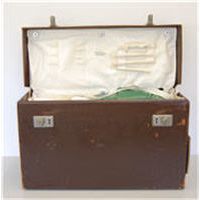ID number: BIRRC-M0144
Institution: Research and Cultural Collections
Named collection: Medical School Collection
Title / Object name: Flying Squad Case
Object type: Medical instrument
Materials: Cotton, Chrome, Glass, Plastic, Rubber, Steel, Catgut, Gauze,
Measurements: 30 x 48 x 26 cm. Open: max height 49 cm
|

|
The case itself is brown leather with a strap on the top-side. The underside of the case has 4 metal 'feet' and there is a 'case-style' lock on the front and side. The fabric lining the underside of the lid is stamped with 'Phillip Harris Ltd. Birmingham'. The main compartment is lined with cream fabric and attached with silver buttons; there are 3 pockets inside this compartment and 20 'loops' of fabric to attach glass phials to the underside of the lid - 2 of these wrapped phials are still in place. The right side of the case opens to reveal 2 separate compartments; 1 is larger than the other.
The main compartment of the case contains: a Schimmelbusch mask used to hold gauze/lint in place to adminster chloroform to the patient, 1 small glass bottle with a black rubber and silver top, 1 length of black thread wound around a brown plastic shape, 9 stainless steel silver catheters (8 are similar, 1 is longer and curved), 1 set of stainless steel silver forceps, 1 currette, 6 pairs of stainless steel scissor-like items with convex blades, 1 pair of large stainless steel scissors, 1 set of stainless steel tweezers with 4 holes on each side, 5 small stainless steel scissors with ridges on the inside of the blades, 2 pairs of stainless steel scissors, 1 pair of stainless steel scissors with a lever-like handle, 1 green plastic apron, 1 roll of cloth containing 2 scissor-like items and a packet with 2 gold and 3 silver surgical needles, 1 piece of cream coloured cloth.
The pockets on the underside of the lid contain: 6 packets of 'sterlised surgical sutures' (catgut)' and 6 paper wrapped glass phials of catgut
The bottom compartments contain: 2 card original boxes with metal dental forceps and 1 boil-sterliser containing a set of stainless steel forceps, 2 scissor-like items, 2 unknown metal items, and a section of thik,orange plastic tubing.
Notes: The first organised obsetric flying squad was established by H.J. Thomson in Scotland in 1933; its aim was to provide emergency back up for GPs and midwives involved in home births. Dame Hilda Lloyd introduced the use of flying squads in the Birmingham area. Typically consisting of an obstetrician, anaesthetist, and a midwife, the flying squad services were activated by a phone call for assistance. Many calls were made during the 1930-50s due to mother's haemorrhaging after giving birth or because of complications arising from 'back-street' abortions.
|